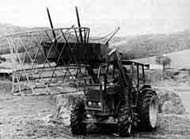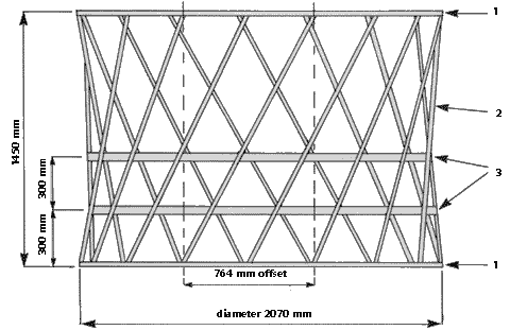
Round bale self-feeders for cattle
Introduction
All fodder conservation systems waste a certain amount of feed. These losses occur during harvesting, storage and feeding out. Round bale systems are no exception, and often have very high losses. Feeding losses are often overlooked, but incorrect feeding out of round bales can easily result in wastage greater than the combined losses that occur during harvesting and storage.
There are a number of ways of feeding round bales to cattle. Purpose-built mechanical feeders are available that can distribute either whole bales or part-bales in an even windrow for cattle to feed on. Producers without such equipment can place a whole bale in the paddock and either roll it out like a thick mat or leave it standing and allow the cattle to feed themselves.
However, if cattle are allowed free access to hay they can cause large losses by walking and sleeping on the material and fouling it. This happens more often when feed is plentiful. Apart from spoilage of the hay, large areas of pasture beneath it can be damaged, and this is often evident well into the next season.
Round bale self-feeders represent a positive step towards reducing the losses associated with the feeding of cattle with round bales. Self-feeders are very simple and reduce losses dramatically by allowing only feeding cattle to have access to the hay.
Feeder design
There are many different cattle feeders on the market, but they can be broadly classified into two groups: slant bar feeders and cradle-type feeders.
Slant bar feeders

Slant bar feeders are very simple and are generally cheaper than cradle-type feeders. They consist of a top and a bottom ring connected by a series of slanted side bars equally spaced around the circumference. The feeders are lightweight and can be tipped onto their sides and rolled to a new site. To load the feeder, place the bale on the ground on its end, then roll the feeder up to it and tip it over the bale.
The slanted side bars are spaced according to personal preference, the circumference of the ring, and the type of cattle (that is, polled or horned), but are generally about 370–400 mm apart. There are two bands or another ring around the circumference near the ground to stop access at the base and to help retain loose material. The bars are slanted to ensure that cattle keep their heads in the feeder while eating and do not grab material and pull it out, losing hay onto the ground in the process.
Bale size determines the diameter of the feeder. The more common 1.5 × 1.2 m bales (5 × 4 ft) fit neatly into a feeder made from standard 6.5 m lengths of steel, thus saving on materials and manufacturing costs. Several larger models are made in two sections that are bolted together. This allows units to be stacked inside each other, saving on transport costs. Unlike cradle feeders, slant bar feeders do not have roofs to protect the hay because their lightweight construction makes them liable to blow over if a roof is fitted.
Slant bar self-feeders are commercially available. However, they are relatively simple to construct and can be made in the farm workshop with little trouble. The construction procedure and diagram are given below.
Cradle feeders

Cradle feeders support the bale in a raised position above the ground. For this reason they are of heavier construction than are slant bar feeders and are consequently more expensive. In a cradle feeder the round bale sits on its side. The cradle is half-moon shaped in section, and generally supports the bale with a number of bars at 400–500 mm centres; however, there is one design that uses mesh to form the cradle. Some designs have a tray beneath the bale to stop hay from falling to the ground; others, which support the bale at about 400 mm from the ground, have no such plate.
Cradle feeders have bars across each end to prevent open access by stock. On most models the bars at one end are removable and the bale is loaded into the cradle. However, there is one design where the whole cradle tilts to the ground; the bale is placed in the cradle and the whole thing is then tilted back into position with the bale forks.
Like slant feeders, cradle feeders are made to suit particular bale sizes. Generally, however, they are made to suit the large 1.8 × 1.5 m (6 × 5 ft) bales, as this size can also handle smaller bales without limiting access to the feed. Because they are quite heavy, cradle feeders must be repositioned with a tractor and forks. Many units are galvanised for longer life, and one design incorporates a roof over the bale.
Other designs
The main purpose of a self-feeder is to restrict access so that stock only feed on the hay and do not walk on it and foul it. Also available are gate systems, which the cattle can push to follow the form of the bale as it is eaten. These fold up easily for transportation.
Round bale feeders reduce feedout losses to a minimum, since cattle can make full use of the bale and there is little leaf loss compared with the losses from other systems. The bale can be completely consumed without moving the feeder. Another advantage is that weed seeds, if there are any in the bale, are concentrated in a very small area. Ideally, self-feeders should be situated on a well-drained area to prevent spoilage and bogging by the cattle.
Constructing a slant bar self-feeder

As stated previously, the size of the bale determines the diameter of the feeder. The following feeder design makes the most efficient use of steel, but suits a 1.5 × 1.2 m (5 × 4 ft) bale only. For larger bales (1.8 × 1.5 m, or 6 × 5 ft), additional lengths of steel must be used.
Self-feeders must be strongly constructed yet be light in weight. The circular design gives strength, and 20 mm diameter pipe together with 25 mm rectangular hollow section (RHS) is quite strong enough.
The most difficult part of building a feeder is getting the top and bottom rings formed from a straight length of RHS. Some farmers have successfully used pipe benders, but it is easier, neater and much quicker to get your local engineer to roll the rings for you. Use 25 mm RHS rather than pipe for the rings so that the slant bars can be easily welded to them. The slant bars can also be made from RHS, but 25 mm RHS is generally dearer than 20 mm NB (nominal bore) pipe; however, if they are comparable in price, use RHS as it is easier to weld.
The feeder should be about 1.45 m high, which you can achieve by cutting the slant bars at equal lengths of 1.625 m (four bars from a standard 6.5 m length of steel) and offsetting them top and bottom by 764 mm around the circumference. You will need 17 slant bars for each feeder (slightly over four standard lengths of steel). Place two bands of light strip at 300 mm spacings around the base of the feeder to help retain loose material.
As feeders are used in wet conditions, they should be painted to guard against rust, and elevated slightly when not in use to stop the bottom ring from rusting.
| Item | Quantity | Description |
|---|---|---|
| 1 | 2 × 6.5 m | Rings—25 × 25 ×2.6 mm RHS |
| 2 | 17 × 1.625 m | Slant bars—20 mm NB pipe (black) |
| 3 | 2 × 6.6 m | Strip—40 × 3 mm flat |
Acknowledgment
This Agfact was originally written by S. J. Butt of NSW Agriculture.

